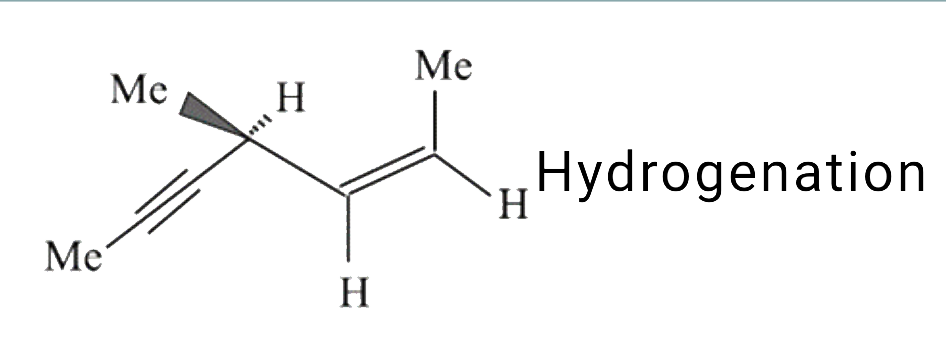Hydrogenation of benzoyl chloride in the presence of Pd/BaSO4 gives :
benzyl alcohol
benzoic acid
benzaldehyde
toluene
The correct Answer is:C
To solve the question regarding the hydrogenation of benzoyl chloride in the presence of Pd/BaSO4, we can follow these steps:
Step 1: Understand the Reactants
Benzoyl chloride (C6H5COCl) consists of a benzene ring (C6H5) attached to a carbonyl group (C=O) and a chlorine atom (Cl).
Step 2: Identify the Catalyst
The catalyst mentioned is Pd/BaSO4, which is known as Lindlar's catalyst. This catalyst is used for the selective hydrogenation of alkynes and can also facilitate the reduction of other functional groups.
Step 3: Reaction Mechanism
When benzoyl chloride undergoes hydrogenation in the presence of Lindlar's catalyst, the carbonyl group (C=O) is reduced to an aldehyde (C=O becomes C=OH) while the chlorine atom (Cl) is replaced by a hydrogen atom (H).
Step 4: Write the Product
The product formed from the hydrogenation of benzoyl chloride is benzyldehyde (C6H5CHO) and hydrochloric acid (HCl) as a byproduct.
Step 5: Evaluate the Options
From the options provided:
1. Benzyl chloride - Incorrect
2. Benzoic acid - Incorrect
3. Benzyldehyde - Correct
4. Toluene - Incorrect
Thus, the correct answer is benzyldehyde.
Final Answer:
The hydrogenation of benzoyl chloride in the presence of Pd/BaSO4 gives benzyldehyde.
---
Benzoyl chloride (C6H5COCl) consists of a benzene ring (C6H5) attached to a carbonyl group (C=O) and a chlorine atom (Cl).
The catalyst mentioned is Pd/BaSO4, which is known as Lindlar's catalyst. This catalyst is used for the selective hydrogenation of alkynes and can also facilitate the reduction of other functional groups.
When benzoyl chloride undergoes hydrogenation in the presence of Lindlar's catalyst, the carbonyl group (C=O) is reduced to an aldehyde (C=O becomes C=OH) while the chlorine atom (Cl) is replaced by a hydrogen atom (H).
The product formed from the hydrogenation of benzoyl chloride is benzyldehyde (C6H5CHO) and hydrochloric acid (HCl) as a byproduct.
From the options provided:
1. Benzyl chloride - Incorrect
2. Benzoic acid - Incorrect
3. Benzyldehyde - Correct
4. Toluene - Incorrect
The hydrogenation of benzoyl chloride in the presence of Pd/BaSO4 gives benzyldehyde.
Topper's Solved these Questions
- P-BLOCK ELEMENT (BORON AND CARBON FAMILY)BOOK - RESONANCE ENGLISHCHAPTER - P-BLOCK ELEMENT (BORON AND CARBON FAMILY)EXERCISE - PART - III : OLYMPIAD PROBLEMS (PREVIOUS YEARS) STAGE - II (INDIAN NATIONAL CHEMISTRY OLYMPIAD (INCHO)) Problem 1
11 Videos
- P-BLOCK ELEMENT (BORON AND CARBON FAMILY)BOOK - RESONANCE ENGLISHCHAPTER - P-BLOCK ELEMENT (BORON AND CARBON FAMILY)EXERCISE - PART - III : OLYMPIAD PROBLEMS (PREVIOUS YEARS) STAGE - II (INDIAN NATIONAL CHEMISTRY OLYMPIAD (INCHO)) Problem 2
8 Videos
- P-BLOCK ELEMENT (BORON AND CARBON FAMILY)BOOK - RESONANCE ENGLISHCHAPTER - P-BLOCK ELEMENT (BORON AND CARBON FAMILY)EXERCISE - SECTION-4
3 Videos
- P BLOCK ELEMENTSBOOK - RESONANCE ENGLISHCHAPTER - P BLOCK ELEMENTSEXERCISE - PART -II
23 Videos
- P-BLOCK ELEMENTS (HALOGEN & NOBLE GASES)BOOK - RESONANCE ENGLISHCHAPTER - P-BLOCK ELEMENTS (HALOGEN & NOBLE GASES)EXERCISE - APSP PART-3
22 Videos
Similar Questions
Knowledge Check
Hydrogenation of benzoyl chloride in the presence of Pd on BaSO4 gives
ABenzyl alcoholBBenzaldehydeCBenzoic acidDPhenol.Hydrogenation of benzoyl chloride in the presence of Pd on BaSO4 gives
ABenzyl alcoholBBenzaldehydeCBenzoic acidDPhenol.Hydrogenation of benzoyl chloride in the presence of Pd on BaSO4 gives
ABenzyl alcoholBBenzaldehydeCBenzoic acidDPhenol.
Name the electrophile produced in the reaction of benzene with benzoyl chloride in the presence of anhydrous AlCl3. Name the reaction also.
View SolutionWrite chemical equations for the following reactions:
(i) Propanone is treated with dilute Ba(OH)2
(ii) Acetophenone is treated with Zn (Hg)/Conc. HCI
(iii) Benzoyl chloride is hydrogenated in presence of Pd/BaSO4.
View SolutionThe reaction of toluene with chlorine in the presence of ferric chloride gives mainly
View Solution Hydrogenation of the above compound in the presence of sodium in liquid ammonia gives -
Hydrogenation of the above compound in the presence of sodium in liquid ammonia gives -
View SolutionThe reaction of p−aminophenol with one mole of acetyl chloride in presence of pyridine gives :
View Solution
